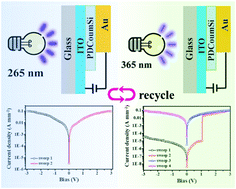A recyclable and photocontrollable resistive memory device based on polycoumarinsiloxanes†
Abstract
Organic polymer semiconductor based resistive-type memory devices exhibiting a series of excellent performance have attracted increasing attention. However, most of the polymer-based memory devices would not be reused and thus plenty of electronic waste has been produced inevitably. To develop recyclable memory materials, a photocontrollable coumarin based polysiloxane material, polycoumarinsiloxane, was synthesised by the Heck cross-coupling reaction. Polycoumarinsiloxanes can form a crosslinking net (PDCoumSi) under the irradiation of UV at λ ∼ 365 nm, which can transform into a linear polymer (PCoumSi) again under the irradiation of UV at λ ∼ 265 nm. According to J–V chracteristics, PCoumSi does not display bistable electrical behaviour, because of which it cannot store data and be used as a memory device, but PDCoumSi shows a distinct write-once-read-many times memory (WORM) behaviour with a high switching current ratio of 1.0–5.0 × 103 and a low threshold voltage of 0.8–1.2 V. Moreover, the memory has no significant degradation for at least 4000 s when a constant voltage is applied at ON and OFF states. Furthermore, by irradiating the ON state of PDCoumSi memory under UV at λ ∼ 265 nm to photocleave into PCoumSi and then photocrosslink under UV at λ ∼ 365 nm to obtain PDCoumSi again, we can renew the PDCoumSi WORM memory. Moreover, after 10 cycles, the ON/OFF current ratio and turn on voltage have no significant change, indicating the good photo-recyclability. This work paves a new way for designing photo-recyclable polymer materials for resistive-type memory devices.



 Please wait while we load your content...
Please wait while we load your content...